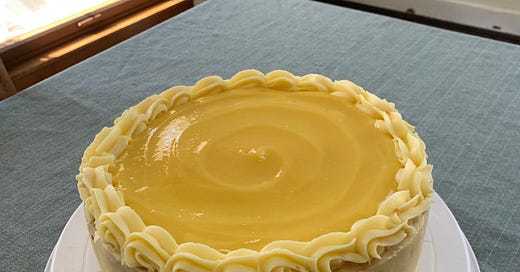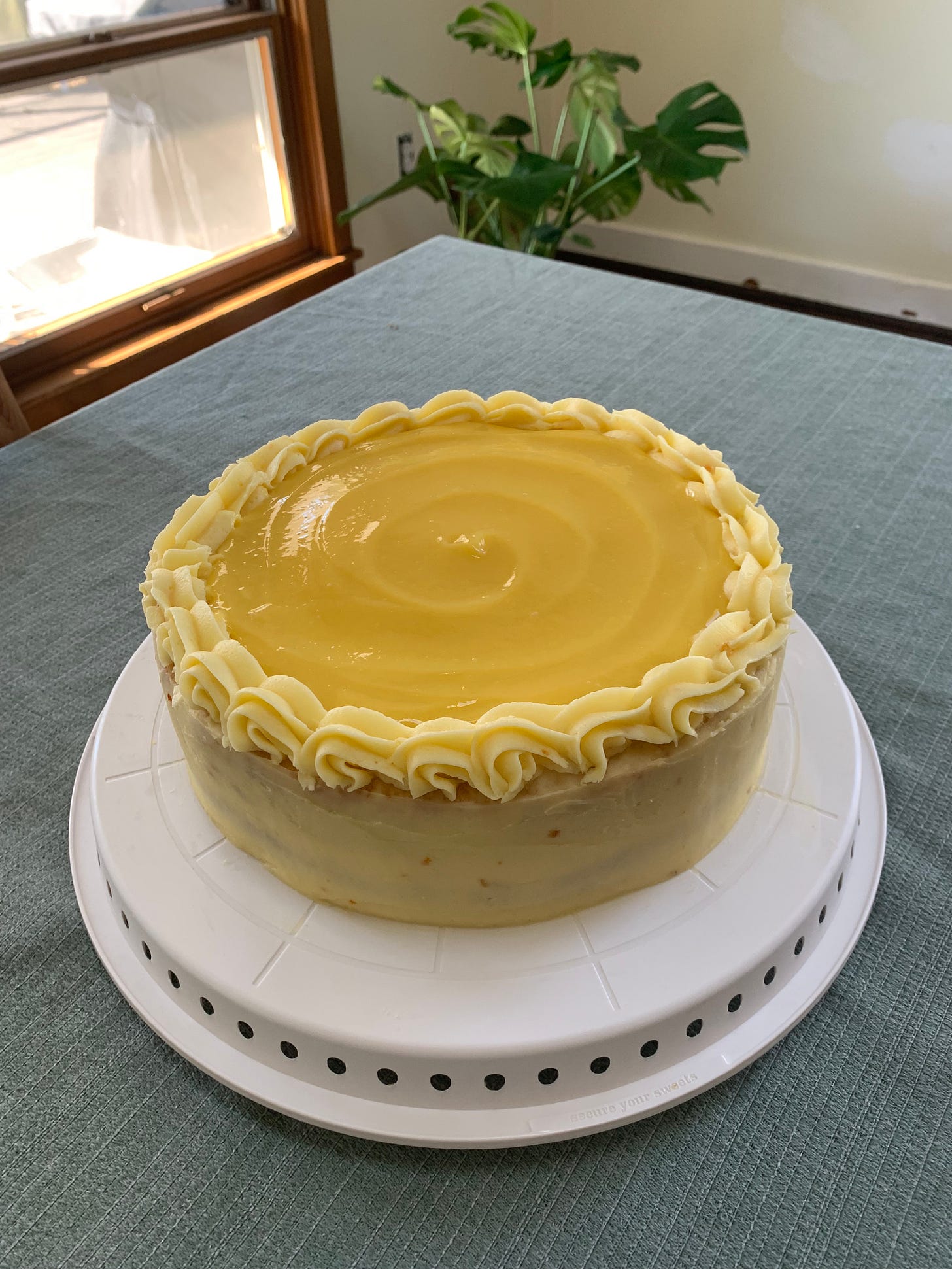It’s the moment you’ve all been waiting for. IT’S CAKE DAY!
The recipe
Yield: one two-layer cake
Time: a few hours to half a day
Ingredients
Orange curd:
juice from two large navel oranges and one large lemon (about ½ c orange juice and 3 tbsp lemon juice, 2/3 c or 225 g juice total)
½ c (215 g) sugar
1 stick (114 g) salted butter at room temperature
4 eggs
Cake:
One Duncan Hines Perfectly Moist Classic Yellow cake mix
¾ c (160 g) vegetable oil
4 eggs
1 c (230 g) orange juice concentrate, thawed
¼ c orange curd (reserved from above)
zest of 2 oranges and 1 lemon (reserved from above)
Frosting:
2 sticks (228 g) salted butter at room temperature
2 tbsp (40 g) orange marmalade
3 c (400 g) powdered sugar
5 tbsp (25 g) orange juice concentrate, thawed
Instructions
Orange curd:
1. Zest oranges and lemon. Set the zest aside to use in the cake. Juice the oranges and the lemon and pour into a large glass or metal bowl.
2. Add the granulated sugar to the bowl with the juice and stir well to combine.
3. Cut the butter into ½ tbsp-size pieces and place in the bowl with the juice and sugar.
4. In a separate bowl, beat the eggs with a fork just until well combined.
5. Fill a small or medium-sized pot with an inch or two of water and heat on low until simmering. Set the bowl of juice mixture in the pot, making sure it does not touch the water. Stir the mixture until the butter melts.
6. Take the bowl off the pot and add half of the warm juice mixture to the eggs, two spoonfuls at a time, gently whisking. Once half of the juice has been incorporated, pour the egg mixture into the glass bowl with the remaining juice, stirring well to combine.
7. Put the bowl back on the pot of simmering water and cook over low heat, stirring constantly, until the orange curd begins to thicken. This can take 20–30 minutes, so be patient! (You’ll know it’s started to thicken when it coats the back of a spoon. If you can draw a line through the curd on the spoon and it doesn’t run back into the line, it’s started thickening.) Keep cooking for another 5–10 minutes until your curd is quite thick, closer to the texture of pudding. If you have a thermometer, cook until it reaches 170°F or 171°F.
8. Remove the curd from the heat and pass it through a fine wire mesh strainer into a heatproof bowl. Discard any bits of cooked egg left in the strainer.
9. Place a piece of plastic wrap directly on top of the curd to keep it from forming a skin and put it in the fridge to cool and set. This will take a few hours.
Cakes:
1. Preheat your oven to 350°F (325°F for dark metal pans). Place one rack in the middle of the oven. Prepare two circular 9-inch cake pans by greasing sides with butter or shortening. Line the bottom of your cake pans with circles of parchment paper. Use a few dots of butter or shortening to keep the parchment in place.
2. Add the cake mix, oil, eggs, orange juice, orange curd, and zest to the bowl of a stand mixer fitted with a whisk attachment. Mix on low speed for about 30 seconds until well combined, then scrape down the bottom and sides of the bowl. Mix on medium speed for 2 minutes, stopping once in the middle to scrape the bottom and sides of the bowl.
3. Divide the mixture evenly between the two cake pans and smooth out the top of the batter with your spatula.
4. Bake the cakes for 19–24 minutes on the middle rack. They are done when a toothpick inserted into the middle of the cake comes out with a few moist crumbs on it. DO NOT wait until the toothpick comes out clean! You will overbake your cakes.
5. Let the cakes cool for 8-10 minutes in their pans, then run a knife around the edges to loosen them. Turn them out onto a piece of foil on a cooling rack. Remove the parchment paper from the bottom of the cakes.
Frosting:
1. Place the butter in the bowl of a stand mixer fitted with the whisk attachment. Beat on medium speed until light and fluffy.
2. Add the orange marmalade to the butter, then beat again until well incorporated.
3. Add the powdered sugar and the orange juice concentrate to the bowl of the stand mixer. Mix on low until ingredients are combined, then increase the speed to high, stopping to scrape down the bowl a few times, until the frosting is light and fluffy. Add more powdered sugar or more marmalade to taste.
Assembly:
1. Place one cake layer on a cake stand. Fill a frosting bag outfitted with a large round tip with about ½ cup of frosting (I used Wilton tip #2A) and pipe a ring of frosting around the edge of the cake, inset a little bit. This is a frosting dam and will hold the orange curd filling in place.
2. Spoon about half of the orange curd on top of the cake, being sure the curd is not higher than the frosting dam.
3. Gently lay the second cake on top of the first one.
4. Fill a bag fitted with a large star tip (I used Wilton #1M) with about ¾ cup of frosting. Set aside.
5. Coat the cake with a very thin layer of frosting, a crumb coat, with an offset spatula. Chill the cake about 30 minutes until the frosting has set. It should no longer feel sticky to the touch.
6. Once the crumb coat is set, frost the sides of the cake.
7. Pipe a border of shells or stars on the top of the cake. If you have any extra frosting left over, squeeze it out of the bag and spread it on top of the cake inside the border. Spoon the rest of the orange curd on the top of the cake and smooth it out, or make a nice swirl with your spoon like I did.
8. Store the cake in the fridge. When you’re ready to serve it, cut slices while cold and let them warm up to room temperature (about 15 minutes) before enjoying.
Notes and tips
Ingredients:
I use Duncan Hines cake mixes because my mom swears by them. If the cake snob’s mom says something, listen up!
I bought a nice French orange marmalade called St. Dalfour that had no added sugar in it. It’s just oranges, pectin, and lemon juice. It was perfect because it added a little tartness to the frosting.
You can find orange juice concentrate in the frozen section of your grocery store. Just make sure to thaw it either in the fridge overnight or in the microwave before using it in the cake.
Orange curd:
The goal of the curd is to cook it low and slow. Cooking it in a bowl set on top of a pot of water heats the curd gently and indirectly so that it doesn’t boil or overcook, making orange scrambled eggs. Make sure your bowl doesn’t touch the simmering water. Do not worry about cooking the curd for a long time; as long as it doesn’t simmer, bubble, or go above 180°F, you’re just fine!
Cakes:
Make sure you use the orange and lemon zest the day you make the curd. If zest sits overnight, it gets bitter.
Once the cakes have cooled to room temperature, cover them with their cooled cake pans to keep them from drying out before you assemble them.
General:
It’s a lot of work to make a whole cake, frosting, and filling in one day as well as assembling the whole thing, so I don’t do it! With this recipe, I recommend making the curd and baking the cakes the first day, then on the second day make the frosting and assemble.
A cold cake slices really neatly, which is why I have you slice it cold, but cake tastes way better at room temperature, and not just because the textures of the frosting and cake are softer. Your taste buds are more sensitive when food is warmer, and the aromatic compounds in food are more active at warmer temperatures as well. I know it’s hard not to eat your cake as soon as you slice it, but you put so much effort into making it that you might as well wait the 15 extra minutes to give yourself the best eating experience possible.
The story
I finally worked up the courage to develop a cake recipe for you! It took so long because my mom makes such amazing cakes and taught me so much of what I know that I didn’t think I could improve on her baking perfection. So I decided not to try. I would have to develop a cake flavor she had not made before, which is not an easy task. I ate a very sweet, juicy orange back in February, and I was resolved. I would make an orange cake. It would be flavored only with freshly-squeezed orange juice and zest for the purest flavor possible. It would be delicious! Except it wasn’t. The first cake was bitter, flat, and dense. The orange curd was grainy and runny. When I cut into the cake, the curd oozed right out.
I wasn’t sure where I’d gone wrong, so I did some research. The curd needed to be cooked longer. The typical way you check for doneness of a curd is making sure it coats the back of a spoon, but my curd was still runny even after it passed that test, and it took way longer to thicken than the 10 minutes every recipe had suggested.
Onto the cake. It turns out that orange juice and zest can get bitter if they aren’t used right away. Well, I’d left my zest in the fridge overnight before making the cake, which is why it did not bake up well. Bake your cake on the same day you make your orange curd to prevent this! The cake was dense because it had too many wet ingredients, so I left out the yogurt and some of the orange juice on subsequent tests. Then the cake wasn’t orangey enough (My recipe tasters said it tasted like a creamsicle, which is not what I was going for. I wanted it to taste like someone sliced up a fresh, juicy orange and magicked it into cake form), so I had to abandon my purist ideals about fresh juice and use frozen concentrate (I mean, I could have boiled down fresh juice into a concentrate myself, but even I balked at the idea of that amount of work, so I figured you would, too).
The frosting needed extra flavor even with the concentrate, so I went back to the store for a third time and found myself a fancy marmalade. Many tries and much puzzle-solving later, here is the recipe I ended with. I hope you are as satisfied with your cake as I was with mine, though I wish you fewer failed attempts along the way!
Spread the love
If you like this recipe, please recommend Confessions of a Cake Snob to someone you know! Please share this newsletter with a friend, comment on the website, or bake the recipe and let me know how it went for you! Email me with baking questions and suggestions at confessionsofacakesnob@substack.com. I’m excited to hear from you!




I know I'm biased, but probably the best cake I have ever eaten